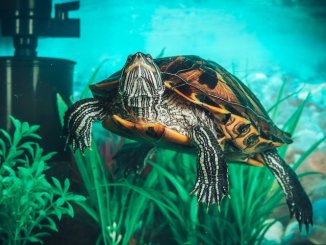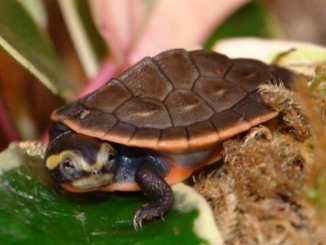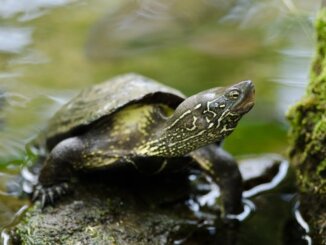The leopard tortoise or mountain tortoise is the second largest tortoise in the world, and it has beautiful markings. The leopard tortoise originates from the African Savannah regions, where it lives in dry, arid areas and feeds on various vegetation.
There are two leopard tortoise genera: Stigmochelys pardalis and Psammobates pardalis. Leopard tortoises are high-maintenance pets because they need ample living spaces, varied diets, and specific conditions.
Leopard Tortoise Overview
| Common Name | Leopard tortoise |
| Scientific Name | Stigmochelys pardalis, Psammobates pardalis |
| Natural Habitat | Ethiopia, Sudan, Somalia, and South Africa |
| Adult Size | 10–30 inches long |
| Average Lifespan | 50–100 years |
| Diet | Alfalfa grass, leafy weeds, plantain weeds, dandelions, prickly pears, succulents, and sow thistle |
| Housing | A 2-foot-high, 10×10-foot enclosed pen with a temperature of 75–90°F, and 40–60% daytime humidity and 70–80% nighttime humidity |
| Experience Level | Intermediate |
Origin
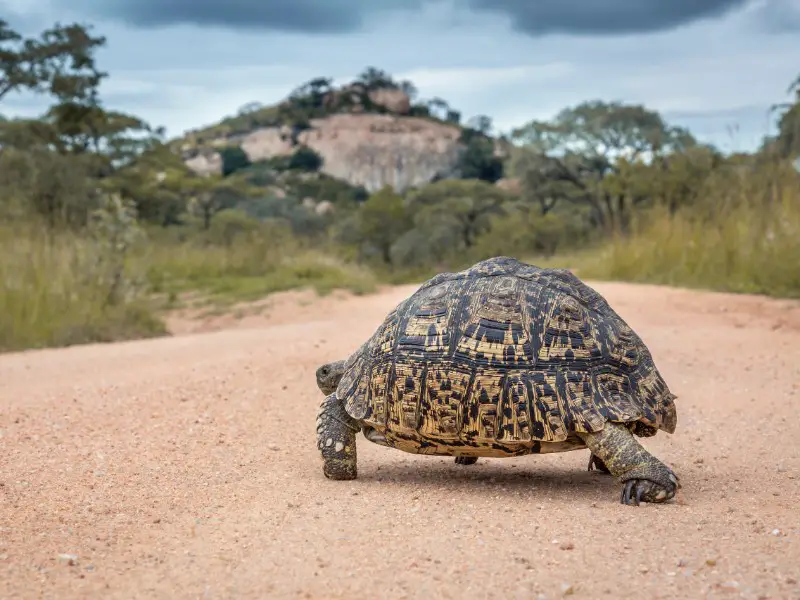
The leopard tortoise (Stigmochelys pardalis, Psammobates pardalis) is common in the wild. It originates from the arid Savannah regions in Sudan, Somalia, Namibia, Ethiopia, Angola, South Africa, and East Africa. These regions only have a few months of rain each year.
Leopard tortoises are commonly found living where water sources are available. Leopard tortoises adapt to long, dry periods, but are usually found living where water sources are available.
The leopard tortoise is one of Africa’s “Small Five” group of animals. The Small Five animals are the buffalo weaver, elephant shrew, rhinoceros beetle, ant lion, and leopard tortoise. Tourists favor the Big Five from Africa, and the Small Five are the less notable but enigmatic group of miniature safari animals.
Appearance and Behavior
Leopard tortoises earned their name because their beautiful markings resemble those of the large cat of the same name. The genus pardalis is a name that comes from the Latin word meaning ‘spotted.’ Leopard tortoises are sizable pets, with the Stigmochelys pardalis growing larger than the Psammobates pardalis species.
Female leopard tortoises grow faster and bigger than males. Males have longer tails than female leopard tortoises.
Adult leopard tortoises vary in shell shape, degree of patterning, and coloration. Adults typically have high carapaces (top of the shell), steep sides, and no scute above the neck. They have raised dorsal scutes on the shell and a well-developed cavity (bottom). Adults also have well-developed legs, big heads, and spiny scales on their limbs.
Hatchlings begin with yellow shells with black spots, and the yellow becomes darker as the tortoise matures. Its black spots also become more significant and blotchy. The shell goes gray as the leopard tortoise grows old.
Size and Lifespan
The leopard tortoise’s origins influence its size, and the larger of them are from Ethiopia and Somalia, and reach 88 pounds and measure up to 30 inches long. The average length of the smaller of the genera, Psammobates pardalis, is 16 inches, and adults weigh 29 pounds.
Leopard tortoises typically live between 50 and 100 years, and the average captive lifespan is 75 years.
Temperament
Leopard tortoises are peaceful, slow, and unaggressive. They don’t have much personality for tortoise keepers looking for animation. Leopard tortoises make hissing sounds when they feel threatened. They aren’t known as burrowers or climbers.
Female leopard tortoises only burrow during mating season to lay eggs, and male leopards become aggressive toward other males during mating season. Leopard tortoises are loner pets that should only be together for mating season.
Leopard tortoises don’t love constant handling, but they’re not known for biting. Poor housing and diet stress the tortoise. When uncomfortable, Leopard tortoises skittishly retreat into their shells.
Housing Leopard Tortoises
Leopard tortoises prefer hot weather like their natural, African Savannah environment, and need access to freshwater daily. Pens, stock tanks, wooden vivariums, and large tubs work as enclosures.
Leopard tortoises don’t thrive in cold weather, so heat is essential in the enclosure.
Enclosure Size
Indoor and outdoor leopard tortoise pens should measure 10×10 feet with a height of 2 feet. Leopard tortoises require extra height because they’re large pets. Use a 20-gallon aquarium for baby leopard tortoises.
Lighting
Leopard tortoises need sunlight and vitamin D. They bask in the sun and must-have pen shade. A full-spectrum UVB light is crucial for an indoor leopard tortoise. The leopard tortoise needs 10–12 hours of daily UVB exposure.
Follow the instructions for the UVB lamp, as it stops emitting UVB rays at six months. Add a basking light over a flat rock for daily indoor basking.
Temperature and Humidity
Leopard tortoises are cold-blooded, and their environment must be strictly temperature-controlled. The ideal daytime temperature is 75–90°F, and nighttime temperatures above 70°F. Maintain 95°F in the basking area.
Indoor housing for leopard tortoises should have ceramic heater emitters, heat bulbs, and a temperature gradient. Leopard tortoises can’t thrive in cold temperatures or damp conditions. The ideal daytime humidity is 40%–60%, and nighttime humidity is 70%–80%.
Use a humidity gauge or hygrometer to measure the enclosure humidity. Spray the substrate with water at night for higher humidity.
Leopard tortoises shed skin from the head, tail, and limbs. Shedding is normal and healthy if the enclosure matches the natural habitat. Leopard tortoises also shed their shells as they grow. Individual scutes shed and grow back. The shell will get harder, fade in color, and start peeling. The right temperature and humidity helps tortoises shed healthily. Increase the humidity in the enclosure during shedding.
Leopard tortoises hibernate in winter. They dig into the ground, under shrubs, rocks, or logs, and only the shell is visible.
Substrate and Decoration
Use a sand-soil substrate mixture for indoor leopard tortoises. Add Bermuda grass, hay, potting soil, peat moss, or newspaper substrates for the tortoise to feed on, and to discourage the tortoise from ingesting sand. Add a flat basking rock under the basking light.
Use sand or soil substrate outdoors to match the leopard tortoise’s natural habitat. Add a shallow pool for submerging. Include dry and wet areas in the enclosure.
Create a sleeping area for the tortoise with a damp box with moist sphagnum moss, cypress bark, and topsoil covering its floor. Create a humid area for leopard tortoises with a half log of oak soaked in water, where the adults can shelter from the sun as they need to.
Cleaning
Daily spot checks are essential to remove urine, poo, and discarded food from the enclosure. Change the water daily.
Cleaning Indoor Enclosures
Deep-clean an indoor enclosure once a month and change the substrate. Remove the leopard tortoise while cleaning by placing it in an outdoor enclosure or a bathtub. Remove the substrate from the tank or pen, and use an animal disinfectant to disinfect the enclosure.
Disinfect all the rocks, the water bowl, and basking areas with a solution of three parts water to one part F10 animal disinfectant. Soaking the rocks and other decorations in an F10 solution also works well. Clean all substrate residue from the pen corners and from decorations.
Cleaning Outdoor Enclosures
An outdoor enclosure requires fewer deep cleans because it resembles the leopard tortoise’s natural habitat. Do daily spot cleans and water changes, and remove discarded food from the feeding substrate. There’s no need to remove the tortoise from the outdoor enclosure during a deep clean.
Disinfect the enclosure rocks and decorations with a solution of one part F10 animal disinfectant to three parts water. Do the following checks with every deep clean:
- Check and mend and clean the wire mesh around the enclosure
- Check the substrate for moldy spots. Replace moldy and damp substrate patches in the enclosure
- Check for new additions the tortoise needs, such as plants, grass patches, or different substrates
Leopard Tortoise Care
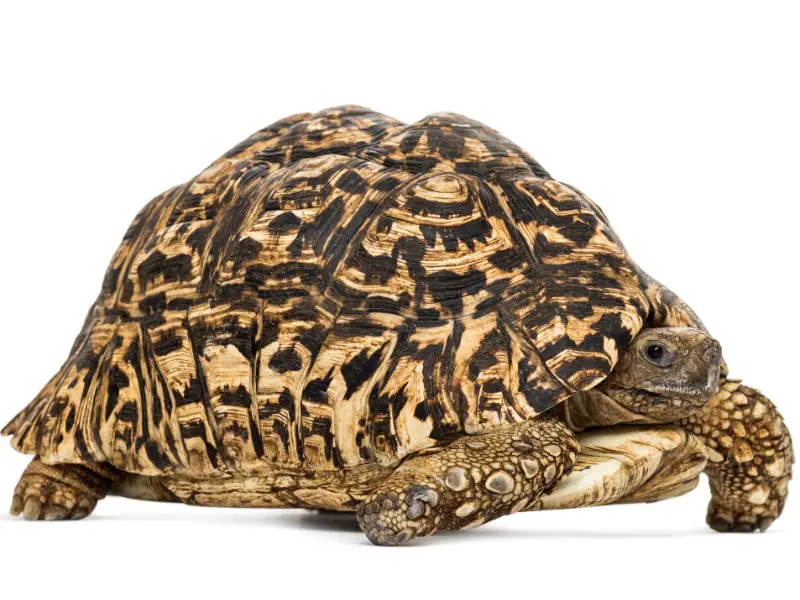
The leopard tortoise is a herbivore with special dietary and handling needs. It’s not a species suited to novice keepers, as leopard tortoises become ill if not cared for properly.
Food and Water
Leopard tortoises are herbivores that graze throughout the day. Most of the tortoise’s diet should consist of grass and plant materials. The leopard tortoise also eats some protein sources like carnivore feces and cuttlebone for calcium, eggshell development, and shell growth.
Use grass and hay substrates to encourage grazing throughout the day. Leopard tortoises also require small amounts of other vegetables once daily, including succulents and prickly pears. Feed the tortoise at the same time every day.
Leopard tortoises eat a variety of plant and animal-based foods, including Alfalfa grass, Timothy hay, leafy weeds, plantain weeds, clovers, orchard grass hay, dandelions, prickly pears, succulents, sow thistle, and spineless Opuntia cactus pads.
Indoor leopard tortoises require more nutrients than other tortoises due to their shade-based dwelling habits. A quality tortoise food gives the leopard tortoise additional vitamin D3 and calcium. A hay substrate gives the tortoise a healthy beak.
Use tortoise food with added calcium during mating season. Increase the leopard tortoise’s food intake by 10% for a month before fall when hibernation begins. Leopard tortoises thrive with additional supplements before hibernation.
Leopard tortoises drink water often, so you should have a 2-inch bowl available at all times.
Never feed leopard tortoises dog or cat food because it damages their kidneys.
There’s no dietary need difference between juveniles and adults.
Handling
Leopard tortoises are skittish and don’t love constant handling. Reserve handling for deep cleans. The leopard tortoise learns to know its keeper, allowing handling more easily with patience. Pick your leopard tortoise up gently by holding the sides of its shell.
Don’t hold the leopard tortoise for long periods. Frequent handling and loud noises are stressful to the tortoise, so they shouldn’t be kept as pets with small, curious children.
Common Health Issues
Leopard tortoises are commonly affected by:
- Respiratory Infections – Picornaviruses, ranaviruses, and herpesviruses are common among leopard tortoises. Symptoms include loud breathing, a clear nasal discharge, and small bubbles at the nose. Keeping the right humidity levels in the tortoise’s enclosure and disinfecting the decorations and rocks prevent respiratory illnesses. Incorrect humidity levels and unclean enclosures cause respiratory infections. Remove the infected tortoise from the enclosure when it has an infection and disinfect the rocks and decorations. Intravenous antibiotics are administered by an exotic vet, and the tortoise requires nasal drops and daily nasal wipes at home to recover
- Shell Rot – This fungal infection is common with captive leopard tortoises. Dry, flaky shells with a bad odor signal shell rot. A clean enclosure, fresh water daily, and enough sunlight or artificial light from the UVB lamp prevents shell rot. Contact an exotic vet for antibiotics and clean the shell daily during recovery. Keep the tortoise away from water for 40 minutes after applying topical antibiotics
- Metabolic Bone Disease – This is a severe illness in captive leopard tortoises. The most common sign is limb deformity. Contact an exotic vet for immediate treatment
Breeding
Leopard tortoises lay between one and two clutches of eggs per season. Leopard tortoise eggs take five to 18 months to hatch, and a heated nesting area is recommended. Build a captive nesting area with these steps:
- Mark an area within the pen measuring 4×6 inches and remove the current substrate
- Replace the substrate with 12–16 inches of 60% topsoil and 40% sand
- Slightly moisten the substrate to loosen it
- Place a basking lamp directly over the area at 86°F
Leopard tortoises must be six to eight years old and more than 12 inches long before reaching sexual maturity. Breeding season is between May and October each year. Pair a healthy, hydrated, and stress-free male leopard tortoise with a larger, healthy, stress-free female.
Larger females more easily accept the male as coupling is simpler, and it’s a bonus if the female has successfully laid eggs before. Male leopard tortoises show an interest in their desired females by trailing and butting them.
Male leopard tortoises also show signs of aggression toward other males before mating. They head-butt and overturn other males. Males approach females by trailing them and “butting” them into submission. It’s recommended to pair the two tortoises when this behavior occurs.
The male leopard tortoise mounts the female when she accepts him. Male leopard tortoises grab the female’s shell and balance themselves with the concave plastron under their shells. Successful copulation is noisy, with grunts, wheezes, and groans.
Gravid female leopard tortoises become loners after successful copulation. The female tortoise then uses her keen smell to find a slightly damp and warm patch to lay her eggs. She digs deep into the substrate with her hind feet and urinates on the ground to soften the soil.
Female leopard tortoises lay between five and 24 eggs per clutch. The female leopard tortoise then pats the hole with her limbs and uses her shell to stamp down sand over the hole, covering the eggs.
The basking lamp provides the right temperature to hatch female leopard tortoises. Raise the temperature another 2°F to hatch male tortoises.
Choosing and Buying a Leopard Tortoise

Leopard tortoises cost between $205 and $5,800. Some sellers include:
Finding adult leopard tortoises can be difficult and pricy. Prices depend on the tortoise size and age. None of the sellers guarantee correct sexting of juveniles. Hatchlings and adults are best found from reputable sellers.
It’s illegal to purchase a leopard tortoise with a shell length shorter than 4 inches. These small tortoises can only be bought for scientific or educational purposes. You should only purchase captive-bred leopard tortoises because wild tortoises will have challenges adapting to the unnatural, captive habitat.
Use these tips to make a leopard tortoise purchase:
- Buy a young leopard tortoise with a golden carapace with clear dark spots or flecking
- Ask the breeder about the tortoise’s dietary needs and lifestyle
- Look for signs of illness, including faded or flaky shells, deformed limbs, and nasal discharge

